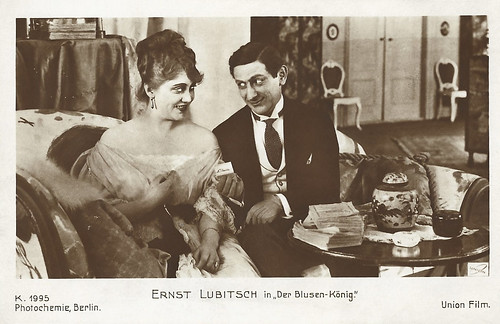
German postcard by Photochemie, no. K.1995. Photo: Union-Film. Ernst Lubitsch in the silent comedy Der Blusenkönig/The Blouse King (Ernst Lubitsch, 1917).
Ernst Lubitsch (1892-1947) was a German-American actor, screenwriter, producer and film director. Der Blusenkönig/The Blouse King (Ernst Lubitsch, 1917) was one of a series of films in which the character of Sally, portrayed by Lubitsch, appeared. Often, for example, this character came from a small town to a big city as a small apprentice and subsequently rose socially. Only a fragment (1/3) of the film remains.

German postcard by Photochemie, no. K. 2629. Photo: Oliver-Film. Hilde Wörner in Der siebente Kuß/The Seventh Kiss (dir. unknown, scripted by Marie Luise Droop, 1918).
Hilde Wörner (1895-1963) was a German stage and film actress, who also worked as a filmmaker. She appeared mainly in silent films and had her own series. Her most notable film was Ernst Lubitsch’s Die Flamme/The Flame (1922).

German postcard by Photochemie, no. K. 2627. Photo: Union. Pola Negri and Reinhold Schünzel in the silent melodrama Das Karussell des Lebens/The Last Payment (Georg Jacoby, 1918).
Polish film actress Pola Negri (1894-1987) achieved notoriety as a femme fatale in silent films between the 1910s and 1930s. German actor and director Reinhold Schünzel (1888-1953) started his successful film career during WW I. He helmed and appeared in more than 100 productions, specializing in light comedies such as the classic ‘drag’ farce Viktor und Viktoria/Victor and Victoria (1933). In 1937 he had to flee Nazi Germany and continued his career in Hollywood.
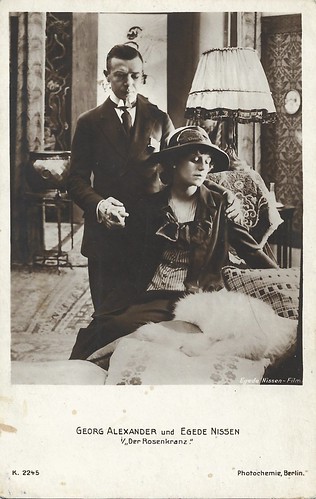
German postcard by Photochemie, no. K. 2245. Photo: Egede Nissen-Film. Georg Alexander and Aud Egede Nissen in the German silent melodrama Der Rosenkranz/The Rosary (Georg Alexander, 1918).
Norwegian film actress Aud Egede Nissen (1893-1974) was a star of German silent cinema. During the 1910s, she produced dozens of her own films. In the 1930s, she returned to Norway, where she appeared in some films but acted mainly on stage. Georg Alexander (1888-1945) was a German actor, director and producer. He belongs to the busiest actors and his career continued smoothly till his death.

German postcard by Photochemie, no. K. 2831. Photo: Treumann-Larsen-Film. Wanda Treumann as the commoner Lore Meisner in Die Prinzessin von Montecuculi/Die Prinzessin von Montecuculi aka Die Schöne von Montecuculi (Robert Heymann, 1918), also with Eugen Burg as Prince Anton XIII (here left of Treumann, who stands in the middle). The man far right of Treumann is maybe Carl Wallauer, who plays the Hauptmarschall/Lord Chamberlain. The two other actors may be Julietta Brandt (Countess Amalie) and Joseph Ewald (artist Helmut Hessler).
Wanda Treumann (1883–1963) belonged among the most popular stars of German cinema before the first World War. Together with Viggo Larsen she also produced more than 80 films in the 1910s, in which she often played the female lead. As an actress, she played in nearly 90 films, but many of them were shorts.
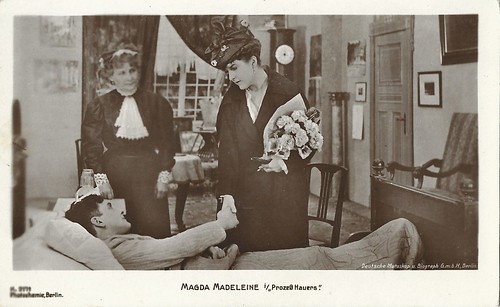
German postcard by Photochemie, no. K. 2171. Photo: Deutsche Mutoskop und Biograph G.m.b.H., Berlin. Magda Madeleine in Der Prozess Hauers/The Hauer process (Willy Zeyn, 1918).
Magda Madeleine, also Maud Madeleine or Magda Mohr (1890s-after 1925) was a stage actress and film actress of the silent film era. In the mid-1910s she acted in many detective films, while in the late 1910s, she had her own series at Deutsche Mutoskop & Biograph.

German postcard by Photochemie, no. K. 3085. Photo: Greenbaum-Film. Ria Jende and Magnus Stifter in Seelenverkäufer/Seller of souls (Carl Boese, 1919).
German-Belgian actress Ria Jende (1898-?) was a star and producer of silent German cinema. She appeared in 40 films before she married and retired.
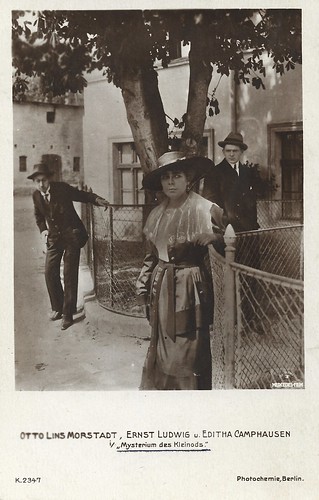
German postcard by Photochemie, no. K. 2347. Photo: Mercedes-Film. Ernst Ludwig, Editha Camphausen, and Otto Lins Morstadt in Das Mysterium des Kleinods/The Mystery of the Jewel aka Der Geisterspuk auf Schloß Diesterberg (Otto Lins Morstadt, 1918).
German actor Ernst Ludwig (1895-?) had a prolific career in German silent cinema between 1914 and 1923, acting mostly supporting parts, in particular in the films by Richard Oswald, e.g. Hoffmanns Erzählungen (1916), Zirkusblut (1916), Es werde Licht, I (1917)), Das Bildnis des Dorian Gray (1917), Königliche Bettler (1917), and Der Schloßherr von Hohenstein (1917). He was also Prof. Ortmann in the Homunculus serial (1916).

German postcard by Photochemie, no. K. 2922. Photo: Erna Morena-Film. Erna Morena in Die 999. Nacht/The 999th night (Fred Sauer, 1919-1920), presented on this card as '1001 Nacht'.
Erna Morena (1885-1962) had an enormous career in German silent cinema in the 1910s and 1920s, and until the mid-1930s she regularly performed in German sound films.

German postcard by Photochemie, no. K. 101. Photo: Eiko-Film. Hedda Vernon in a Hamlet-like outfit.
German actress, writer and producer Hedda Vernon (1866-?) appeared in more than 60 films of the early silent period. During the 1910s she was such a popular film star that she got her own Hedda-Vernon serial.
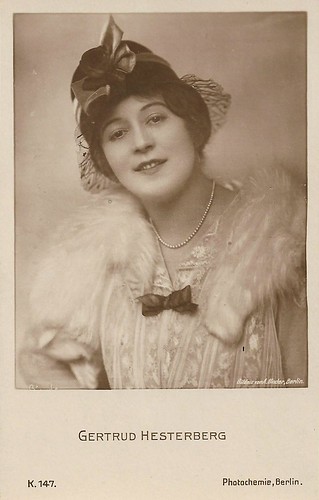
German postcard by Photochemie, no. K. 147. Photo: by Alex Binder, Berlin.
Gertrud 'Trude' Hesterberg (1892-1967) was a German stage and screen actress, cabaret performer, soubrette, and operetta singer, as well as the founder and manager of a cabaret company.
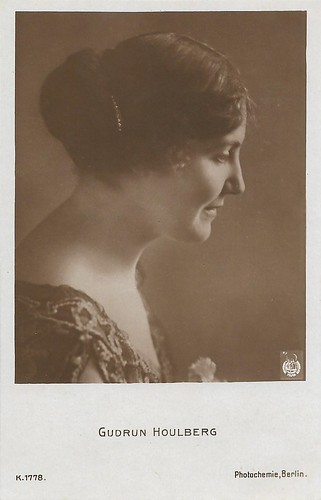
German postcard by Photochemie, no. K. 1778. Photo: Nordisk.
Danish actress Gudrun Houlberg (1889-1940) made her film début with Nordisk Film in 1910 in the silent film Et gensyn. In 1912 she moved to the film department of Skandinavisk-Russisk Handelshus where she appeared in almost 30 films until she was engaged by Nordisk Film in 1916.

German postcard by Photochemie, no. K. 1412. Photo: Alex Binder, Berlin.
Grete Weixler (ca. 1900-after 1922) was a German actress in the silent cinema. From 1914 on, she appeared in secondary roles in melodramas by directors like Carl Boese, Friedrich Zelnik and Lupu Pick.

German postcard by Photochemie, no. K. 1885. Photo: Willinger, Berlin.
Lori Leux (1896-1964) was a German actress, who was known for such silent films as Eine Frau auf Pump gesucht (1914) and Ein Sommernachtstraum (1925). In 1914, she began her career as a singer but she entered the film business in the same year. In 1925 she retired from the film business and appeared both as a singer and actress on stage. In the 1950s, she returned to the screen in supporting roles. Leux was also engaged in racing horses and she owned her own racing stable.
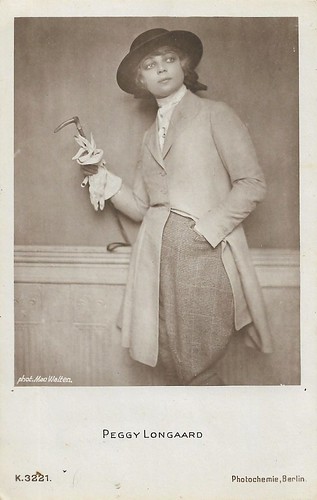
German postcard by Photochemie, no. K. 3221. Photo: MacWalten. Longard's name is spelt as Longaard on this card.
Peggy Longard (1896-?) was a Berlin-born German actress, who had a short career in German silent film between 1919 and 1921.
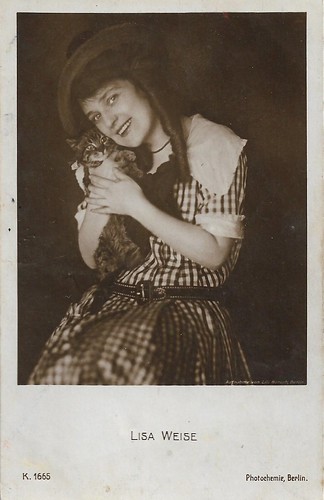
German postcard by Photochemie, Berlin, no. K.1665. Photo: Lili Baruch, Berlin.
German actress Lisa Weise (1880-1952) starred in silent films of the 1910s. Most of her films were directed by Friedrich Zelnik and often her film partner was Karl Beckersachs.
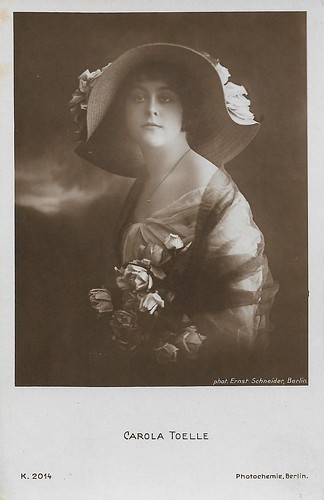
German postcard by Photochemie, Berlin, no. K.2014. Photo: Ernst Schneider, Berlin.
Carola Toelle (1893-1958) was a German actress, in particular in German silent cinema of the late 1910s and early 1920s.

German postcard by Photochemie, Berlin, no. K.153. Photo: Alex Binder, Berlin.
Hermann Wlach (1884-1962) was an Austrian actor. From 1915 to 1922, Wlach appeared in many silent films.

German postcard by Photochemie, Berlin, no. K. 1359. Photo: Alex Binder, Berlin.
Hans Waßmann (1873-1932) was a German film actor. Between 1914 and his death in 1932 Wassmann played in 50 German films, mostly in supporting parts.
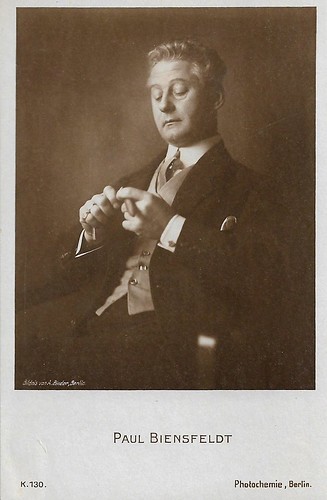
German postcard by Photochemie, Berlin, no. K. 130. Photo: Alex Binder, Berlin.
German film and theatre actor Paul Biensfeldt (1869-1933) appeared in over a hundred silent and sound film productions between 1913 and 1933. He was repeatedly cast by the most renowned directors, such as Fritz Lang, Ernst Lubitsch, Friedrich Wilhelm Murnau, Paul Leni, Robert Wiene and Joe May. He appeared mostly in supporting roles as a valet, dance teacher, policeman or nobleman, but he had somewhat larger roles in the early phase of film in the 1910s.

German postcard by Photochemie, Berlin, no. K.1460. Photo: Willinger.
German ‘dynamite’ director, actor, producer and screenwriter Harry Piel (1892-1963) made over 150 sensational films full of explosions and stunts. With his iron nerves, he was Tom Mix, Douglas Fairbanks and Eddy Polo, all in one person.
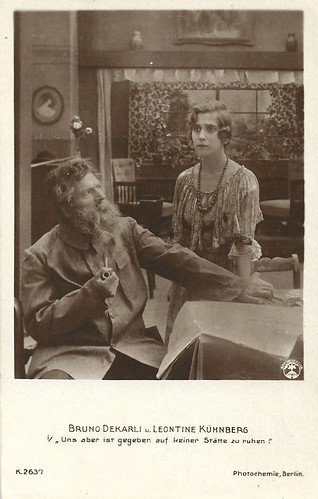
German postcard by Photochemie, Berlin, no. K.2637. Photo: Eichberg-Film. The film title on the card, Uns aber ist gegeben auf keiner Stätte zu ruhen (But to us it is given to rest on no place) is absent on both IMDb and on the German site Filmportal. de. From the six films that Richard Eichberg directed with Leontine Kühnberg in 1918, all for his own company Eichberg-Film, a probable option is Im Zeichen der Schuld (Richard Eichberg, 1918), aka Aus dem Leben eines Vorbestraften/From the life of a convicted man. Filmportal.de lists this as the only film in which Bruno Decarli and Kühnberg played together in a film by Eichberg-Film. The plot deals with a man (Decarli) who, convicted of forging his boss's name, kills the bank director and assumes his identity. However, The German Early Cinema Database does list the film Uns aber ist gegeben, auf keiner Stätte zu ruhen as a separate film (1918), directed by Eichberg, and starring Decarli and Kühnberg. So perhaps, this is a separate film after all.
German actor Bruno Decarli (1877-1950) had a short, but intensive career in silent cinema. Leontine Kühnberg (1889-after 1930) was a German theatre and silent film actress, who began to make films shortly before the outbreak of the First World War. Her participation in two Hermann Sudermann adaptations, Die Geschichte der stillen Mühle (Richard Oswald, 1914) and Der Katzensteg (Max Mack, 1915), brought her recognition. From 1918-1919, she did seven films under the direction of Richard Eichberg.
See also our earlier post on Photochemie. Sources: Filmportal, The German Early Cinema Database and IMDb.
No comments:
Post a Comment